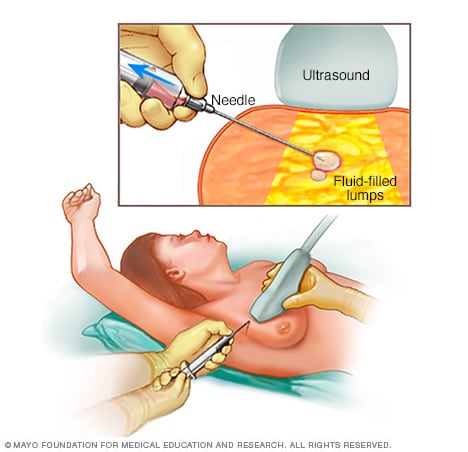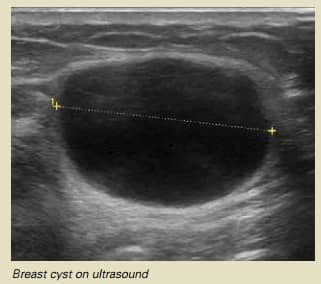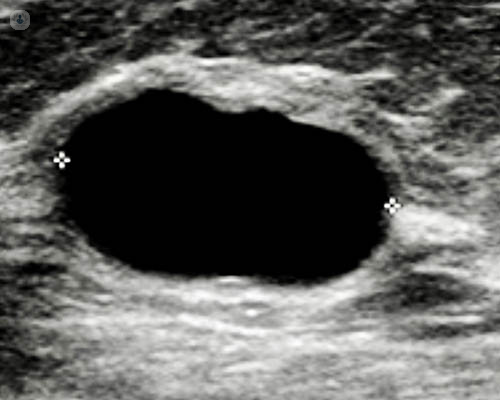Cluster Of Tiny Cysts In Breast
Fibrocystic changes are an exaggerated response of breast tissue to changes of ovarian hormones. Focal fibrocystic changes may appear as solid masses or thin-walled cysts.

Complex Cystic And Solid Breast Mass Radiology Reference Article Radiopaedia Org
They are very common and typically affect women in their 40s who are in perimenopause the period of time before menopause when a woman stops having periods but they can occur at any age.

Cluster of tiny cysts in breast. They are painless so women dont know they have them unless they are detected by a mammogram. Clusters of cysts can form in one breast or both. Most of the time this is non-cancerous extra cell growth but sometimes clusters of microcalcifications can occur in areas of early cancer.
If they seem different or strange to you have your doctor check them right away. Very common - red bumps often like acne are very common. Originally Posted by shisslak.
Breast cysts dont require treatment unless a cyst is large and painful or uncomfortable. 9 can mimic debris. Cysts can develop at any age but are most common in women in their 30s and 40s.
10 Reverberation artifacts see Fig. If calcifications are clustered together or concentrated in one segment of the breast they tend to be viewed with more concern. But since there is a cluster of breast cysts and there is also a solid component present in them the drainage would not help.
A breast cyst is a collection of liquid inside the breast. These changes are sometimes called fibrocystic changes and used to be called fibrocystic disease. Many breast lumps turn out to be caused by fibrosis andor cysts which are non-cancerous benign changes in breast tissue that many women get at some time in their lives.
They will only show up on a mammogram or ultrasound and they often occur in clusters. They are too small to feel but can show up on a mammogram as small bright white spots. You may have one or multiple breast cysts.
The number of cysts in the breast differs from woman to woman. Unlike cancerous tumors which are solid cysts are fluid-filled masses in the breast. Your breasts may feel rope-like and tender especially in the top area of the breast.
You can wait the six months and see it they are disappeared however if you are concerned and not comfortable waiting the six months than call the doctor who ordered the mammogram. They are fluid-filled sacs that grow within the breast tissue and can cause smooth firm lumps to develop. A breast cyst is a localised collection of fluid in the breast.
However on ultrasound they appear as a round clear shape with a distinct outline. Clustered microcysts constitute one of several types of cystic lesions seen on breast ultrasound 1. The reason for this is that a simple drainage will leave the solid cysts behind.
I would suggest that the black areas on the ultasound are fluid filled cysts. This test can help your doctor determine whether a breast lump is fluid filled or solid. Theres no specific rule about when theyll appear.
They usually have liquid inside although some cysts also have a solid content. Its usually caused by a buildup of keratin under the skin. It occurs when fluid fills an empty milk gland.
It can be one or multiple and they can also vary in size. If this were the case a simple drainage of cyst would be enough to treat it. However most of them do not swell to a size big enough to be detectable.
Itll be a clearly defined pouch thats usually quite small around the side of a chickpea or perhaps smaller. Large cysts and clusters of small cysts can usually be seen with mammography. Approximately half of all women will develop breast cysts.
Obstetrics and Gynecology 29 years experience. Cysts are often too small to feel. Breast cysts do not have any symptoms while some may develop within the breast causing breast pain.
Most cysts develop rapidly and then stay the same size. They are less concerning if they are scattered throughout an entire breast or even both breasts. Breast clustered microcysts are quite common estimated to appear in around 6 of all breast ultrasound scans.
A breast cyst is a noncancerous benign fluid-filled sac in the breast. When they do swell it is often a quick process and they vary in size. When a duct becomes blocked or the amount of fluid produced is greater than the amount absorbed fluid accumulates which causes cysts.
Some cysts are too small to feel while others grow up to several inches large enough to make you uncomfortable. A Microcyst on the other hand is very small often less than 2-3 mm. It includes two natural breast conditions occurring together.
Larger cysts can be felt in the breast tissue. Cysts can be single or multiple. Fibrosis and cysts are most common in women of child-bearing age but.
Cyst in breast varies in size since there are some that are tiny while others can grow to several centimeters in diameter. There are often multiple cysts within these tubes. Cluster of breast cysts.
Fluid is constantly being produced and reabsorbed in the milk ducts in the breast. They can appear in. Cysts are very common and are rarely associated with cancer.
The condition doesnt increase your chance of breast cancer and isnt inherently harmful however. But microcysts can be difficult or impossible to see on a mammogram. Learn more about calcifications.
Fibrous breast tissue mammary glands and ducts overreact to the normal hormones produced during ovulation resulting in the development of fibrous lumps andor numerous small multiple cysts lumpy fluid-filled sacs or pockets. Having fibrous tissue as well as benign cysts. A breast cyst is a benign fluid-filled sac in the breast tissue.
Breast calcifications are small clusters of calcium deposits that develop in breast tissue most commonly in women over 50. A small number shrink or continue to grow. A fluid-filled area usually indicates a breast cyst.
About half of these solid masses are usually classified as indeterminate and will eventually require a biopsy. A breast cyst often feels like a grape or a water-filled balloon but sometimes a breast cyst feels firm. Smaller cysts might be impossible to see or feel but can still cause breast tenderness.
An epidermoid cyst is a small slow growing benign cyst most commonly found on the face head neck back or genitals. Tiny cysts called microcysts often develop in clusters. Cluster of breast cysts is not the same as having one cyst.
Clustered microcysts are defined by the BI-RADS as lesions with a cluster of tiny anechoic foci that are individually less than 23 mm with thin 05 mm intervening septa without a discrete solid component. Cysts are fluid-filled bubbles similar to blisters in the breast tissue. Broadly one may classify cysts in the breast as simple cysts and complex or atypical cysts.
56k views Reviewed 2 years ago. Who Gets Breast Cysts. Discrete single cysts or clusters of small cysts may be seen in some Figure Figure3B 3B and andC.
Small simple cysts can appear hypoechoic with 21 of cysts measuring 4 mm or smaller in size described as solid masses in one series as were 13 of cysts measuring 41 to 6 mm and 8 of cysts measuring 61 to 8 mm. Fibrous tissue refers to breast tissue that feels firm and rubbery and may feel similar to ligaments and scar tissue. Among the complex cysts there is one variety known as sponge-like cluster of cystsYour lesion may belong to this varietyComplex cysts generally need to be more carefully assessed followed up or treated.
They might appear to be developing within a specific system of ducts or collecting in one segment of the breast. Cysts are less common in postmenopausal women. All simple cysts larger than 8 mm were appropriately classified.
Breast cysts are fluid-filled sacs inside the breast. Cysts are sacs filled with fluid that can reside in the breast and most of the time are harmless. They are usually noncancerous benign.

Breast Cysts Diagnosis And Treatment Mayo Clinic

Breast Cyst Fact Sheet Westmead Bci

Breast Cysts Should I Be Worried Top Doctors
Posting Komentar untuk "Cluster Of Tiny Cysts In Breast"